CentOS 搭建Graylog集群详解
1. Graylog2 简介
Graylog 是一个简单易用、功能较全面的日志管理工具,相比 ELK 组合, 优点:
- 部署维护简单,一体化解决方案,不像ELK三个独立系统集成。
- 查相比ES json语法,搜索语法更加简单,如 source:mongo AND reponse_time_ms:>5000。
- 内置简单的告警。
- 可以将搜索条件导出为 json格式文本,方便开发调用ES rest api搜索脚本。
- 自己开发采集日志的脚本,并用curl/nc发送到Graylog Server,发送格式是自定义的GELF,Flunted和Logstash都有相应的输出GELF消息的插件。自己开发带来很大的自由度。实际上只需要用inotifywait监控日志的modify事件,并把日志的新增行用curl/netcat发送到Graylog Server就可。
- UI 比较友好,搜索结果高亮显示。
当然,在拓展性上,graylog还是不如ELK。
Graylog整体组成:
- Graylog提供 graylog 对外接口, CPU 密集
- Elasticsearch 日志文件的持久化存储和检索, IO 密集
- MongoDB 存储一些 Graylog 的配置
2. Graylog架构
单server架构 :

Graylog集群架构 :

3. Graylog安装
这里我搭建的是集群方案,但是将ES与Graylog和MongoDB部署在同一台server上。
① 前提条件:
$ sudo yum install java-1.8.-openjdk-headless.x86_64
$ sed -i 's/^SELINUX=enforcing/SELINUX=disabled/' /etc/selinux/config
$ setenforce 0 #安装pwgen
$ sudo yum install epel-release
$ sudo yum install pwgen
② MongoDB安装:
创建/etc/yum.repos.d/mongodb-org-3.2.repo文件,添加如下内容:
[mongodb-org-3.2]
name=MongoDB Repository
baseurl=https://repo.mongodb.org/yum/redhat/$releasever/mongodb-org/3.2/x86_64/
gpgcheck=
enabled=
gpgkey=https://www.mongodb.org/static/pgp/server-3.2.asc
安装MongoDB:
sudo yum install mongodb-org
启动服务:
$ sudo chkconfig --add mongod
$ sudo systemctl daemon-reload
$ sudo systemctl enable mongod.service
$ sudo systemctl start mongod.service
③Elasticsearch安装:
Graylog 2.3.x 支持 Elasticsearch 5.x版本。
首先安装Elastic GPG key以及repository文件,然后yum安装:
$ rpm --import https://artifacts.elastic.co/GPG-KEY-elasticsearch
$ cat /etc/yum.repos.d/elasticsearch.repo
[elasticsearch-.x]
name=Elasticsearch repository for .x packages
baseurl=https://artifacts.elastic.co/packages/5.x/yum
gpgcheck=
gpgkey=https://artifacts.elastic.co/GPG-KEY-elasticsearch
enabled=
autorefresh=
type=rpm-md $ sudo yum install elasticsearch
编辑Elasticsearch配置文件/etc/elasticsearch/elasticsearch.yml,添加cluster信息:
# cat /etc/elasticsearch/elasticsearch.yml
# ======================== Elasticsearch Configuration =========================
#
# NOTE: Elasticsearch comes with reasonable defaults for most settings.
# Before you set out to tweak and tune the configuration, make sure you
# understand what are you trying to accomplish and the consequences.
#
# The primary way of configuring a node is via this file. This template lists
# the most important settings you may want to configure for a production cluster.
#
# Please consult the documentation for further information on configuration options:
# https://www.elastic.co/guide/en/elasticsearch/reference/index.html
#
# ---------------------------------- Cluster -----------------------------------
#
# Use a descriptive name for your cluster:
#
cluster.name: graylog
#
# ------------------------------------ Node ------------------------------------
#
# Use a descriptive name for the node:
#
node.name: shop-log-
#
# Add custom attributes to the node:
#
#node.attr.rack: r1
#
# ----------------------------------- Paths ------------------------------------
#
# Path to directory where to store the data (separate multiple locations by comma):
#
path.data: /data/elasticsearch/db
#
# Path to log files:
#
path.logs: /data/elasticsearch/logs
#
# ----------------------------------- Memory -----------------------------------
#
# Lock the memory on startup:
#
#bootstrap.memory_lock: true
#
# Make sure that the heap size is set to about half the memory available
# on the system and that the owner of the process is allowed to use this
# limit.
#
# Elasticsearch performs poorly when the system is swapping the memory.
#
# ---------------------------------- Network -----------------------------------
#
# Set the bind address to a specific IP (IPv4 or IPv6):
#
network.host: 10.2.2.42
#
# Set a custom port for HTTP:
#
http.port:
#
# For more information, consult the network module documentation.
#
# --------------------------------- Discovery ----------------------------------
#
# Pass an initial list of hosts to perform discovery when new node is started:
# The default list of hosts is ["127.0.0.1", "[::1]"]
#
# 这里给其他两个节点的地址
discovery.zen.ping.unicast.hosts: ["10.2.2.41", "10.2.2.43"]
#
# Prevent the "split brain" by configuring the majority of nodes (total number of master-eligible nodes / + ):
#
discovery.zen.minimum_master_nodes:
#
# For more information, consult the zen discovery module documentation.
#
# ---------------------------------- Gateway -----------------------------------
#
# Block initial recovery after a full cluster restart until N nodes are started:
#
#gateway.recover_after_nodes:
#
# For more information, consult the gateway module documentation.
#
# ---------------------------------- Various -----------------------------------
#
# Require explicit names when deleting indices:
#
#action.destructive_requires_name: true
http.cors.enabled: true
http.cors.allow-origin: "*"
elasticsearch.yml
启动Elasticsearch服务:
$ sudo chkconfig --add elasticsearch
$ sudo systemctl daemon-reload
$ sudo systemctl enable elasticsearch.service
$ sudo systemctl restart elasticsearch.service
④Graylog安装
$ sudo rpm -Uvh https://packages.graylog2.org/repo/packages/graylog-2.3-repository_latest.rpm
$ sudo yum install graylog-server
编辑graylog配置文件 /etc/graylog/server/server.conf,添加 password_secret和 password_secret_sha2(必须)
可以使用 echo -n yourpassword | sha256sum 命令来生成 password_secret_sha2。
设置rest_listen_uri以及web_listen_uri为公共ip或公共hostname,以便连接graylog。
# cat /etc/graylog/server/server.conf
############################
# GRAYLOG CONFIGURATION FILE
############################
#
# This is the Graylog configuration file. The file has to use ISO -/Latin- character encoding.
# Characters that cannot be directly represented in this encoding can be written using Unicode escapes
# as defined in https://docs.oracle.com/javase/specs/jls/se8/html/jls-3.html#jls-3.3, using the \u prefix.
# For example, \u002c.
#
# * Entries are generally expected to be a single line of the form, one of the following:
#
# propertyName=propertyValue
# propertyName:propertyValue
#
# * White space that appears between the property name and property value is ignored,
# so the following are equivalent:
#
# name=Stephen
# name = Stephen
#
# * White space at the beginning of the line is also ignored.
#
# * Lines that start with the comment characters ! or # are ignored. Blank lines are also ignored.
#
# * The property value is generally terminated by the end of the line. White space following the
# property value is not ignored, and is treated as part of the property value.
#
# * A property value can span several lines if each line is terminated by a backslash (鈥榎鈥 character.
# For example:
#
# targetCities=\
# Detroit,\
# Chicago,\
# Los Angeles
#
# This is equivalent to targetCities=Detroit,Chicago,Los Angeles (white space at the beginning of lines is ignored).
#
# * The characters newline, carriage return, and tab can be inserted with characters \n, \r, and \t, respectively.
#
# * The backslash character must be escaped as a double backslash. For example:
#
# path=c:\\docs\\doc1
# # If you are running more than one instances of Graylog server you have to select one of these
# instances as master. The master will perform some periodical tasks that non-masters won't perform.
is_master = false # The auto-generated node ID will be stored in this file and read after restarts. It is a good idea
# to use an absolute file path here if you are starting Graylog server from init scripts or similar.
node_id_file = /etc/graylog/server/node-id # You MUST set a secret to secure/pepper the stored user passwords here. Use at least characters.
# Generate one by using for example: pwgen -N -s
password_secret = BjwAAuTEWDQNtAKhUL5lQ3TvW41saWseKpRdTSrecBFifsCJDXak4fudnACBcaMyl0I4yzJDF801Kyasdfsdfasdfasdfasd # The default root user is named 'admin'
root_username = admin # You MUST specify a hash password for the root user (which you only need to initially set up the
# system and in case you lose connectivity to your authentication backend)
# This password cannot be changed using the API or via the web interface. If you need to change it,
# modify it in this file.
# Create one by using for example: echo -n yourpassword | shasum -a
# and put the resulting hash value into the following line
root_password_sha2 = 926c00b3f65df24b65a9a7b58a989add920c81441dccd2
dsfasdfasdf
# The email address of the root user.
# Default is empty
#root_email = "" # The time zone setting of the root user. See http://www.joda.org/joda-time/timezones.html for a list of valid time zones.
# Default is UTC
root_timezone = Asia/Shanghai # Set plugin directory here (relative or absolute)
plugin_dir = /usr/share/graylog-server/plugin # REST API listen URI. Must be reachable by other Graylog server nodes if you run a cluster.
# When using Graylog Collectors, this URI will be used to receive heartbeat messages and must be accessible for all collectors.
rest_listen_uri = http://10.2.2.42:9000/api/ # REST API transport address. Defaults to the value of rest_listen_uri. Exception: If rest_listen_uri
# is set to a wildcard IP address (0.0.0.0) the first non-loopback IPv4 system address is used.
# If set, this will be promoted in the cluster discovery APIs, so other nodes may try to connect on
# this address and it is used to generate URLs addressing entities in the REST API. (see rest_listen_uri)
# You will need to define this, if your Graylog server is running behind a HTTP proxy that is rewriting
# the scheme, host name or URI.
# This must not contain a wildcard address (0.0.0.0).
rest_transport_uri = http://10.2.2.42:9000/api/ # Enable CORS headers for REST API. This is necessary for JS-clients accessing the server directly.
# If these are disabled, modern browsers will not be able to retrieve resources from the server.
# This is enabled by default. Uncomment the next line to disable it.
#rest_enable_cors = false # Enable GZIP support for REST API. This compresses API responses and therefore helps to reduce
# overall round trip times. This is enabled by default. Uncomment the next line to disable it.
#rest_enable_gzip = false # Enable HTTPS support for the REST API. This secures the communication with the REST API with
# TLS to prevent request forgery and eavesdropping. This is disabled by default. Uncomment the
# next line to enable it.
#rest_enable_tls = true # The X. certificate chain file in PEM format to use for securing the REST API.
#rest_tls_cert_file = /path/to/graylog.crt # The PKCS# private key file in PEM format to use for securing the REST API.
#rest_tls_key_file = /path/to/graylog.key # The password to unlock the private key used for securing the REST API.
#rest_tls_key_password = secret # The maximum size of the HTTP request headers in bytes.
#rest_max_header_size = # The maximal length of the initial HTTP/1.1 line in bytes.
#rest_max_initial_line_length = # The size of the thread pool used exclusively for serving the REST API.
#rest_thread_pool_size = # Comma separated list of trusted proxies that are allowed to set the client address with X-Forwarded-For
# header. May be subnets, or hosts.
#trusted_proxies = 127.0.0.1/, :::::::/ # Enable the embedded Graylog web interface.
# Default: true
web_enable = true # Web interface listen URI.
# Configuring a path for the URI here effectively prefixes all URIs in the web interface. This is a replacement
# for the application.context configuration parameter in pre-2.0 versions of the Graylog web interface.
web_listen_uri = http://10.2.2.42:9000/ # Web interface endpoint URI. This setting can be overriden on a per-request basis with the X-Graylog-Server-URL header.
# Default: $rest_transport_uri
web_endpoint_uri = http://42.111.111.111:9000/api # Enable CORS headers for the web interface. This is necessary for JS-clients accessing the server directly.
# If these are disabled, modern browsers will not be able to retrieve resources from the server.
web_enable_cors = true # Enable/disable GZIP support for the web interface. This compresses HTTP responses and therefore helps to reduce
# overall round trip times. This is enabled by default. Uncomment the next line to disable it.
#web_enable_gzip = false # Enable HTTPS support for the web interface. This secures the communication of the web browser with the web interface
# using TLS to prevent request forgery and eavesdropping.
# This is disabled by default. Uncomment the next line to enable it and see the other related configuration settings.
#web_enable_tls = true # The X. certificate chain file in PEM format to use for securing the web interface.
#web_tls_cert_file = /path/to/graylog-web.crt # The PKCS# private key file in PEM format to use for securing the web interface.
#web_tls_key_file = /path/to/graylog-web.key # The password to unlock the private key used for securing the web interface.
#web_tls_key_password = secret # The maximum size of the HTTP request headers in bytes.
#web_max_header_size = # The maximal length of the initial HTTP/1.1 line in bytes.
#web_max_initial_line_length = # The size of the thread pool used exclusively for serving the web interface.
#web_thread_pool_size = # List of Elasticsearch hosts Graylog should connect to.
# Need to be specified as a comma-separated list of valid URIs for the http ports of your elasticsearch nodes.
# If one or more of your elasticsearch hosts require authentication, include the credentials in each node URI that
# requires authentication.
#
# Default: http://127.0.0.1:9200
elasticsearch_hosts = http://grayloguser:3KKLg8294CE0@10.2.2.41:9200,http://grayloguser:3KKLg8294CE0@10.2.2.42:9200,http://grayloguser:3KKLg8294CE0@10.2.2.43:9200 # Maximum amount of time to wait for successfull connection to Elasticsearch HTTP port.
#
# Default: Seconds
#elasticsearch_connect_timeout = 10s # Maximum amount of time to wait for reading back a response from an Elasticsearch server.
#
# Default: seconds
#elasticsearch_socket_timeout = 60s # Maximum idle time for an Elasticsearch connection. If this is exceeded, this connection will
# be tore down.
#
# Default: inf
#elasticsearch_idle_timeout = -1s # Maximum number of total connections to Elasticsearch.
#
# Default:
#elasticsearch_max_total_connections = # Maximum number of total connections per Elasticsearch route (normally this means per
# elasticsearch server).
#
# Default:
#elasticsearch_max_total_connections_per_route = # Maximum number of times Graylog will retry failed requests to Elasticsearch.
#
# Default:
#elasticsearch_max_retries = # Enable automatic Elasticsearch node discovery through Nodes Info,
# see https://www.elastic.co/guide/en/elasticsearch/reference/5.4/cluster-nodes-info.html
#
# WARNING: Automatic node discovery does not work if Elasticsearch requires authentication, e. g. with Shield.
#
# Default: false
#elasticsearch_discovery_enabled = true # Filter for including/excluding Elasticsearch nodes in discovery according to their custom attributes,
# see https://www.elastic.co/guide/en/elasticsearch/reference/5.4/cluster.html#cluster-nodes
#
# Default: empty
#elasticsearch_discovery_filter = rack: # Frequency of the Elasticsearch node discovery.
#
# Default: 30s
# elasticsearch_discovery_frequency = 30s # Enable payload compression for Elasticsearch requests.
#
# Default: false
#elasticsearch_compression_enabled = true # Graylog will use multiple indices to store documents in. You can configured the strategy it uses to determine
# when to rotate the currently active write index.
# It supports multiple rotation strategies:
# - "count" of messages per index, use elasticsearch_max_docs_per_index below to configure
# - "size" per index, use elasticsearch_max_size_per_index below to configure
# valid values are "count", "size" and "time", default is "count"
#
# ATTENTION: These settings have been moved to the database in 2.0. When you upgrade, make sure to set these
# to your previous .x settings so they will be migrated to the database!
rotation_strategy = count # (Approximate) maximum number of documents in an Elasticsearch index before a new index
# is being created, also see no_retention and elasticsearch_max_number_of_indices.
# Configure this if you used 'rotation_strategy = count' above.
#
# ATTENTION: These settings have been moved to the database in 2.0. When you upgrade, make sure to set these
# to your previous .x settings so they will be migrated to the database!
elasticsearch_max_docs_per_index = # (Approximate) maximum size in bytes per Elasticsearch index on disk before a new index is being created, also see
# no_retention and elasticsearch_max_number_of_indices. Default is 1GB.
# Configure this if you used 'rotation_strategy = size' above.
#
# ATTENTION: These settings have been moved to the database in 2.0. When you upgrade, make sure to set these
# to your previous .x settings so they will be migrated to the database!
#elasticsearch_max_size_per_index = # (Approximate) maximum time before a new Elasticsearch index is being created, also see
# no_retention and elasticsearch_max_number_of_indices. Default is day.
# Configure this if you used 'rotation_strategy = time' above.
# Please note that this rotation period does not look at the time specified in the received messages, but is
# using the real clock value to decide when to rotate the index!
# Specify the time using a duration and a suffix indicating which unit you want:
# 1w = week
# 1d = day
# 12h = hours
# Permitted suffixes are: d for day, h for hour, m for minute, s for second.
#
# ATTENTION: These settings have been moved to the database in 2.0. When you upgrade, make sure to set these
# to your previous .x settings so they will be migrated to the database!
#elasticsearch_max_time_per_index = 1d # Disable checking the version of Elasticsearch for being compatible with this Graylog release.
# WARNING: Using Graylog with unsupported and untested versions of Elasticsearch may lead to data loss!
#elasticsearch_disable_version_check = true # Disable message retention on this node, i. e. disable Elasticsearch index rotation.
#no_retention = false # How many indices do you want to keep?
#
# ATTENTION: These settings have been moved to the database in 2.0. When you upgrade, make sure to set these
# to your previous .x settings so they will be migrated to the database!
elasticsearch_max_number_of_indices = # Decide what happens with the oldest indices when the maximum number of indices is reached.
# The following strategies are availble:
# - delete # Deletes the index completely (Default)
# - close # Closes the index and hides it from the system. Can be re-opened later.
#
# ATTENTION: These settings have been moved to the database in 2.0. When you upgrade, make sure to set these
# to your previous .x settings so they will be migrated to the database!
retention_strategy = delete # How many Elasticsearch shards and replicas should be used per index? Note that this only applies to newly created indices.
# ATTENTION: These settings have been moved to the database in Graylog 2.2.. When you upgrade, make sure to set these
# to your previous settings so they will be migrated to the database!
elasticsearch_shards =
elasticsearch_replicas = # Prefix for all Elasticsearch indices and index aliases managed by Graylog.
#
# ATTENTION: These settings have been moved to the database in Graylog 2.2.. When you upgrade, make sure to set these
# to your previous settings so they will be migrated to the database!
elasticsearch_index_prefix = graylog # Name of the Elasticsearch index template used by Graylog to apply the mandatory index mapping.
# Default: graylog-internal
#
# ATTENTION: These settings have been moved to the database in Graylog 2.2.. When you upgrade, make sure to set these
# to your previous settings so they will be migrated to the database!
#elasticsearch_template_name = graylog-internal # Do you want to allow searches with leading wildcards? This can be extremely resource hungry and should only
# be enabled with care. See also: http://docs.graylog.org/en/2.1/pages/queries.html
allow_leading_wildcard_searches = false # Do you want to allow searches to be highlighted? Depending on the size of your messages this can be memory hungry and
# should only be enabled after making sure your Elasticsearch cluster has enough memory.
allow_highlighting = true # Analyzer (tokenizer) to use for message and full_message field. The "standard" filter usually is a good idea.
# All supported analyzers are: standard, simple, whitespace, stop, keyword, pattern, language, snowball, custom
# Elasticsearch documentation: https://www.elastic.co/guide/en/elasticsearch/reference/2.3/analysis.html
# Note that this setting only takes effect on newly created indices.
#
# ATTENTION: These settings have been moved to the database in Graylog 2.2.. When you upgrade, make sure to set these
# to your previous settings so they will be migrated to the database!
elasticsearch_analyzer = standard # Global request timeout for Elasticsearch requests (e. g. during search, index creation, or index time-range
# calculations) based on a best-effort to restrict the runtime of Elasticsearch operations.
# Default: 1m
#elasticsearch_request_timeout = 1m # Global timeout for index optimization (force merge) requests.
# Default: 1h
#elasticsearch_index_optimization_timeout = 1h # Maximum number of concurrently running index optimization (force merge) jobs.
# If you are using lots of different index sets, you might want to increase that number.
# Default:
#elasticsearch_index_optimization_jobs = # Time interval for index range information cleanups. This setting defines how often stale index range information
# is being purged from the database.
# Default: 1h
#index_ranges_cleanup_interval = 1h # Batch size for the Elasticsearch output. This is the maximum (!) number of messages the Elasticsearch output
# module will get at once and write to Elasticsearch in a batch call. If the configured batch size has not been
# reached within output_flush_interval seconds, everything that is available will be flushed at once. Remember
# that every outputbuffer processor manages its own batch and performs its own batch write calls.
# ("outputbuffer_processors" variable)
output_batch_size = # Flush interval (in seconds) for the Elasticsearch output. This is the maximum amount of time between two
# batches of messages written to Elasticsearch. It is only effective at all if your minimum number of messages
# for this time period is less than output_batch_size * outputbuffer_processors.
output_flush_interval = # As stream outputs are loaded only on demand, an output which is failing to initialize will be tried over and
# over again. To prevent this, the following configuration options define after how many faults an output will
# not be tried again for an also configurable amount of seconds.
output_fault_count_threshold =
output_fault_penalty_seconds = # The number of parallel running processors.
# Raise this number if your buffers are filling up.
processbuffer_processors =
outputbuffer_processors = #outputbuffer_processor_keep_alive_time =
#outputbuffer_processor_threads_core_pool_size =
#outputbuffer_processor_threads_max_pool_size = # UDP receive buffer size for all message inputs (e. g. SyslogUDPInput).
#udp_recvbuffer_sizes = # Wait strategy describing how buffer processors wait on a cursor sequence. (default: sleeping)
# Possible types:
# - yielding
# Compromise between performance and CPU usage.
# - sleeping
# Compromise between performance and CPU usage. Latency spikes can occur after quiet periods.
# - blocking
# High throughput, low latency, higher CPU usage.
# - busy_spinning
# Avoids syscalls which could introduce latency jitter. Best when threads can be bound to specific CPU cores.
processor_wait_strategy = blocking # Size of internal ring buffers. Raise this if raising outputbuffer_processors does not help anymore.
# For optimum performance your LogMessage objects in the ring buffer should fit in your CPU L3 cache.
# Must be a power of . (, , , ...)
ring_size = inputbuffer_ring_size =
inputbuffer_processors =
inputbuffer_wait_strategy = blocking # Enable the disk based message journal.
message_journal_enabled = true # The directory which will be used to store the message journal. The directory must me exclusively used by Graylog and
# must not contain any other files than the ones created by Graylog itself.
#
# ATTENTION:
# If you create a seperate partition for the journal files and use a file system creating directories like 'lost+found'
# in the root directory, you need to create a sub directory for your journal.
# Otherwise Graylog will log an error message that the journal is corrupt and Graylog will not start.
message_journal_dir = /var/lib/graylog-server/journal # Journal hold messages before they could be written to Elasticsearch.
# For a maximum of hours or GB whichever happens first.
# During normal operation the journal will be smaller.
#message_journal_max_age = 12h
#message_journal_max_size = 5gb #message_journal_flush_age = 1m
#message_journal_flush_interval =
#message_journal_segment_age = 1h
#message_journal_segment_size = 100mb # Number of threads used exclusively for dispatching internal events. Default is .
#async_eventbus_processors = # How many seconds to wait between marking node as DEAD for possible load balancers and starting the actual
# shutdown process. Set to if you have no status checking load balancers in front.
lb_recognition_period_seconds = # Journal usage percentage that triggers requesting throttling for this server node from load balancers. The feature is
# disabled if not set.
#lb_throttle_threshold_percentage = # Every message is matched against the configured streams and it can happen that a stream contains rules which
# take an unusual amount of time to run, for example if its using regular expressions that perform excessive backtracking.
# This will impact the processing of the entire server. To keep such misbehaving stream rules from impacting other
# streams, Graylog limits the execution time for each stream.
# The default values are noted below, the timeout is in milliseconds.
# If the stream matching for one stream took longer than the timeout value, and this happened more than "max_faults" times
# that stream is disabled and a notification is shown in the web interface.
#stream_processing_timeout =
#stream_processing_max_faults = # Length of the interval in seconds in which the alert conditions for all streams should be checked
# and alarms are being sent.
#alert_check_interval = # Since 0.21 the Graylog server supports pluggable output modules. This means a single message can be written to multiple
# outputs. The next setting defines the timeout for a single output module, including the default output module where all
# messages end up.
#
# Time in milliseconds to wait for all message outputs to finish writing a single message.
#output_module_timeout = # Time in milliseconds after which a detected stale master node is being rechecked on startup.
#stale_master_timeout = # Time in milliseconds which Graylog is waiting for all threads to stop on shutdown.
#shutdown_timeout = # MongoDB connection string
# See https://docs.mongodb.com/manual/reference/connection-string/ for details
mongodb_uri = mongodb://graylog:75PN76Db66En@10.2.2.41:27017,10.2.2.42:27017,10.2.2.43:27017/graylog?replicaSet=rs0 # Authenticate against the MongoDB server
#mongodb_uri = mongodb://grayloguser:secret@localhost:27017/graylog # Use a replica set instead of a single host
#mongodb_uri = mongodb://grayloguser:secret@localhost:27017,localhost:27018,localhost:27019/graylog # Increase this value according to the maximum connections your MongoDB server can handle from a single client
# if you encounter MongoDB connection problems.
mongodb_max_connections = # Number of threads allowed to be blocked by MongoDB connections multiplier. Default:
# If mongodb_max_connections is , and mongodb_threads_allowed_to_block_multiplier is ,
# then threads can block. More than that and an exception will be thrown.
# http://api.mongodb.com/java/current/com/mongodb/MongoOptions.html#threadsAllowedToBlockForConnectionMultiplier
mongodb_threads_allowed_to_block_multiplier = # Drools Rule File (Use to rewrite incoming log messages)
# See: http://docs.graylog.org/en/2.1/pages/drools.html
#rules_file = /etc/graylog/server/rules.drl # Email transport
#transport_email_enabled = false
#transport_email_hostname = mail.example.com
#transport_email_port =
#transport_email_use_auth = true
#transport_email_use_tls = true
#transport_email_use_ssl = true
#transport_email_auth_username = you@example.com
#transport_email_auth_password = secret
#transport_email_subject_prefix = [graylog]
#transport_email_from_email = graylog@example.com # Specify and uncomment this if you want to include links to the stream in your stream alert mails.
# This should define the fully qualified base url to your web interface exactly the same way as it is accessed by your users.
#transport_email_web_interface_url = https://graylog.example.com # The default connect timeout for outgoing HTTP connections.
# Values must be a positive duration (and between and when converted to milliseconds).
# Default: 5s
#http_connect_timeout = 5s # The default read timeout for outgoing HTTP connections.
# Values must be a positive duration (and between and when converted to milliseconds).
# Default: 10s
#http_read_timeout = 10s # The default write timeout for outgoing HTTP connections.
# Values must be a positive duration (and between and when converted to milliseconds).
# Default: 10s
#http_write_timeout = 10s # HTTP proxy for outgoing HTTP connections
#http_proxy_uri = # Disable the optimization of Elasticsearch indices after index cycling. This may take some load from Elasticsearch
# on heavily used systems with large indices, but it will decrease search performance. The default is to optimize
# cycled indices.
#
# ATTENTION: These settings have been moved to the database in Graylog 2.2.. When you upgrade, make sure to set these
# to your previous settings so they will be migrated to the database!
#disable_index_optimization = true # Optimize the index down to <= index_optimization_max_num_segments. A higher number may take some load from Elasticsearch
# on heavily used systems with large indices, but it will decrease search performance. The default is .
#
# ATTENTION: These settings have been moved to the database in Graylog 2.2.. When you upgrade, make sure to set these
# to your previous settings so they will be migrated to the database!
#index_optimization_max_num_segments = # The threshold of the garbage collection runs. If GC runs take longer than this threshold, a system notification
# will be generated to warn the administrator about possible problems with the system. Default is second.
#gc_warning_threshold = 1s # Connection timeout for a configured LDAP server (e. g. ActiveDirectory) in milliseconds.
#ldap_connection_timeout = # Disable the use of SIGAR for collecting system stats
#disable_sigar = false # The default cache time for dashboard widgets. (Default: seconds, minimum: second)
#dashboard_widget_default_cache_time = 10s # Automatically load content packs in "content_packs_dir" on the first start of Graylog.
#content_packs_loader_enabled = true # The directory which contains content packs which should be loaded on the first start of Graylog.
content_packs_dir = /usr/share/graylog-server/contentpacks # A comma-separated list of content packs (files in "content_packs_dir") which should be applied on
# the first start of Graylog.
# Default: empty
content_packs_auto_load = grok-patterns.json # For some cluster-related REST requests, the node must query all other nodes in the cluster. This is the maximum number
# of threads available for this. Increase it, if '/cluster/*' requests take long to complete.
# Should be rest_thread_pool_size * average_cluster_size if you have a high number of concurrent users.
proxied_requests_thread_pool_size =
server.conf
启动graylog服务:
$ sudo chkconfig --add graylog-server
$ sudo systemctl daemon-reload
$ sudo systemctl enable graylog-server.service
$ sudo systemctl start graylog-server.service
4. 多节点集群配置安装
① MongoDB集群配置:
修改所有mongdb节点的配置文件/etc/mongod.conf,添加集群replication信息replSetName: rs0,并重启服务。
# cat /etc/mongod.conf
# mongod.conf # for documentation of all options, see:
# http://docs.mongodb.org/manual/reference/configuration-options/ # where to write logging data.
systemLog:
destination: file
logAppend: true
path: /var/log/mongodb/mongod.log # Where and how to store data.
storage:
dbPath: /var/lib/mongo
journal:
enabled: true
# engine:
# mmapv1:
# wiredTiger: # how the process runs
processManagement:
fork: true # fork and run in background
pidFilePath: /var/run/mongodb/mongod.pid # location of pidfile # network interfaces
net:
port:
# bindIp: 127.0.0.1 # Listen to local interface only, comment to listen on all interfaces. #security: #operationProfiling: replication:
replSetName: rs0
#sharding: ## Enterprise-Only Options #auditLog: #snmp:
mongod.conf
$ sudo systemctl restart mongod.service
在集群其中一个节点,启动mongo命令行:
$ mongo
初始化mongodb集群,使用本机hostname或IP加端口:
$ rs.initiate( {
_id : "rs0",
members: [ { _id : , host : "mongodb0.example.net:27017" } ]
})
验证集群配置:
$ rs.conf()
{
"_id" : "rs0",
"version" : ,
"protocolVersion" : NumberLong(),
"members" : [
{
"_id" : ,
"host" : "mongodb0.example.net:27017",
"arbiterOnly" : false,
"buildIndexes" : true,
"hidden" : false,
"priority" : ,
"tags" : {
},
"slaveDelay" : NumberLong(),
"votes" :
}
],
"settings" : {
"chainingAllowed" : true,
"heartbeatIntervalMillis" : ,
"heartbeatTimeoutSecs" : ,
"electionTimeoutMillis" : ,
"catchUpTimeoutMillis" : ,
"getLastErrorModes" : {
},
"getLastErrorDefaults" : {
"w" : ,
"wtimeout" :
},
"replicaSetId" : ObjectId("585ab9df685f726db2c6a840")
}
}
rs.conf()
将其他节点加入集群,并查看集群配置:
rs0:PRIMARY> rs.add("mongodb1.example.net")
rs0:PRIMARY> rs.add("mongodb2.example.net")
rs0:PRIMARY> rs.status()
创建graylog数据库,并添加graylog用户,赋予readWrite和dbAdmin权限:
rs0:PRIMARY> use graylog
switched to db graylog
rs0:PRIMARY> db.createUser( {
user: "graylog",
pwd: "75PN76Db66En",
roles: [ { role: "readWrite", db: "graylog" } ]
});
rs0:PRIMARY> db.grantRolesToUser( "graylog" , [ { role: "dbAdmin", db: "graylog" } ])
rs0:PRIMARY> show users
rs0:PRIMARY> db.auth("graylog","75sdfsdsdfn")
② Elasticsearch 集群配置:
修改elasticsearch配置文件并重启服务:
# cat /etc/elasticsearch/elasticsearch.yml | grep cluster.name
cluster.name: graylog
# cat /etc/elasticsearch/elasticsearch.yml | grep discovery.zen.ping
discovery.zen.ping.unicast.hosts: ["10.2.2.41", "10.2.2.43"]
# cat /etc/elasticsearch/elasticsearch.yml | grep network.host
network.host: 10.2.2.42
③ graylog集群配置
graylog master节点修改配置server.conf 中 is_master = true,其他节点为false,同时rest_listen_uri以及rest_transport_uri必须可以被集群中的其他节点连通。
修改mongodb连接配置:
# cat /etc/graylog/server/server.conf|grep mongodb_uri
mongodb_uri = mongodb://graylog:75PsdfsDb66En@10.2.2.41:27017,10.2.2.42:27017,10.2.2.43:27017/graylog?replicaSet=rs0
修改elasticsearch连接配置:
# cat /etc/graylog/server/server.conf|grep elasticsearch_hosts
elasticsearch_hosts = http://grayloguser:3KKLg8sdf340@10.2.2.41:9200,http://grayloguser:3KKLg8294CE0@10.2.2.42:9200,http://grayloguser:
3KKLg8sdf340
@10.2.2.43:9200
开启web界面:
# cat /etc/graylog/server/server.conf|grep web_enable
web_enable = true
④ 创建负载均衡器,对graylog配置负载均衡,我使用的是微软云负载均衡,这里不再说明。
此时可以通过 负载均衡器IP:9000 对graylog进行访问。
5. 日志接入
接入 syslog
首先在 webui 创建 input:
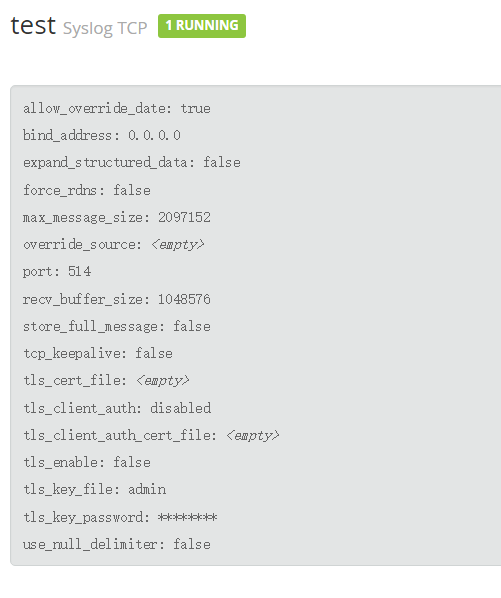
以 rsyslog 为例:
/etc/rsyslog.d/graylog.conf: *.* @@x.x.x.x:;RSYSLOG_SyslogProtocol23Format service rsyslog restart
即可查看该 input 的 message:
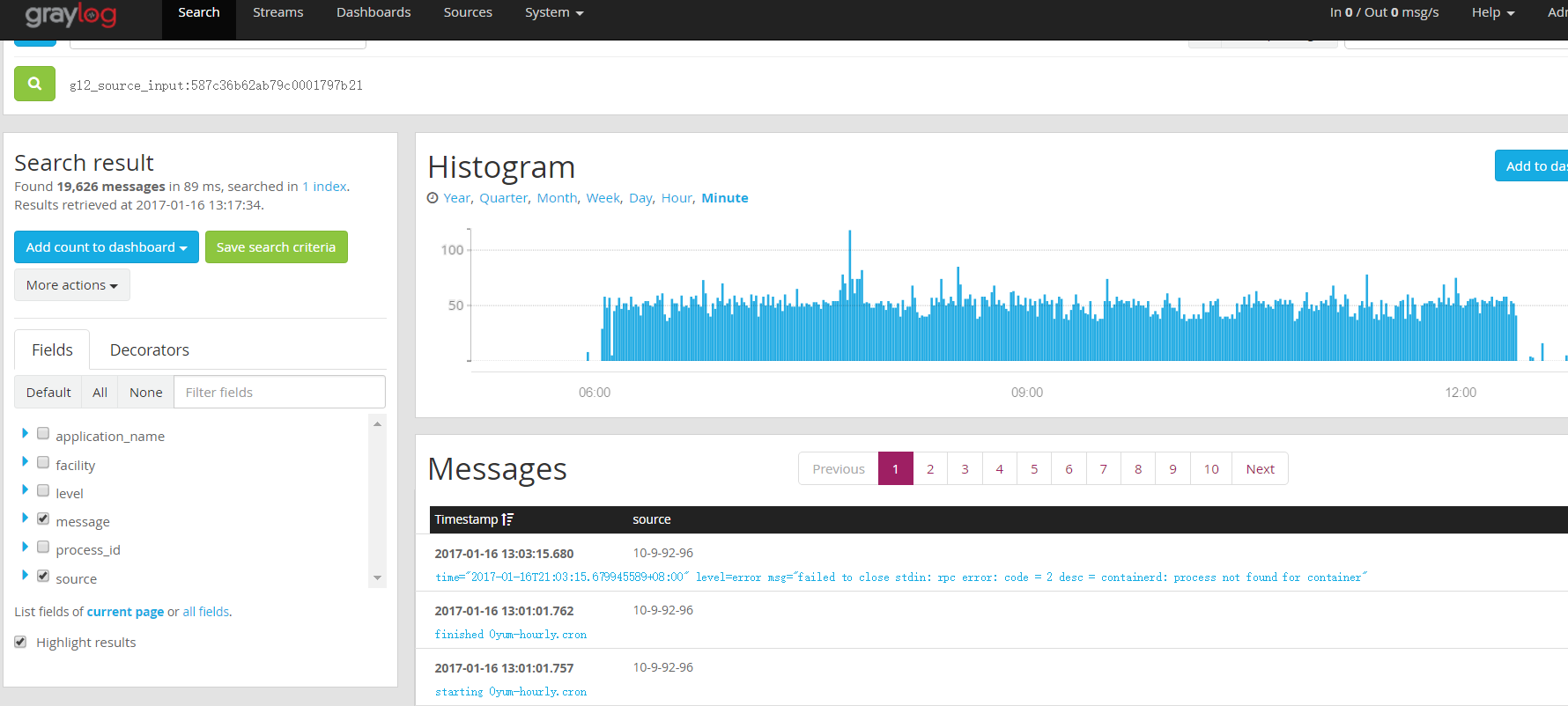
GELF (http 为例)
GELF (Graylog Extended Log Format) 可以接收结构化的事件, 支持压缩(GZIP’d or ZLIB’d)和分块。
GELF message:
- version
string - host
string - short_message
string - full_message
string - timestamp
number - level
number - facility
string - line
number - file
string - _[additional field]
stringornumber, 通过_前缀添加自定义的字段
- version
新建一个 GELF HTTP input:
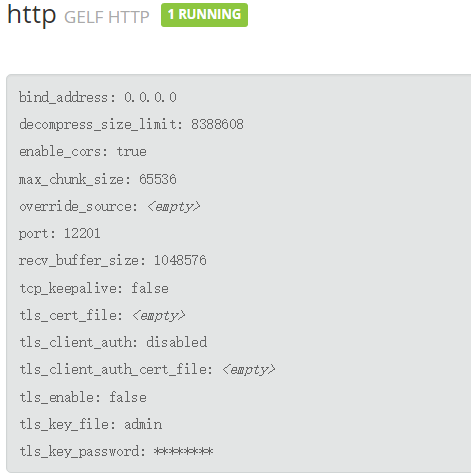
推送日志:
curl -XPOST http://106.75.62.142:12201/gelf -p0 -d '{"message":"这是一条消息", "host":"172.3.3.3", "facility":"test", "topic": "meme"}'
查看推送的日志:
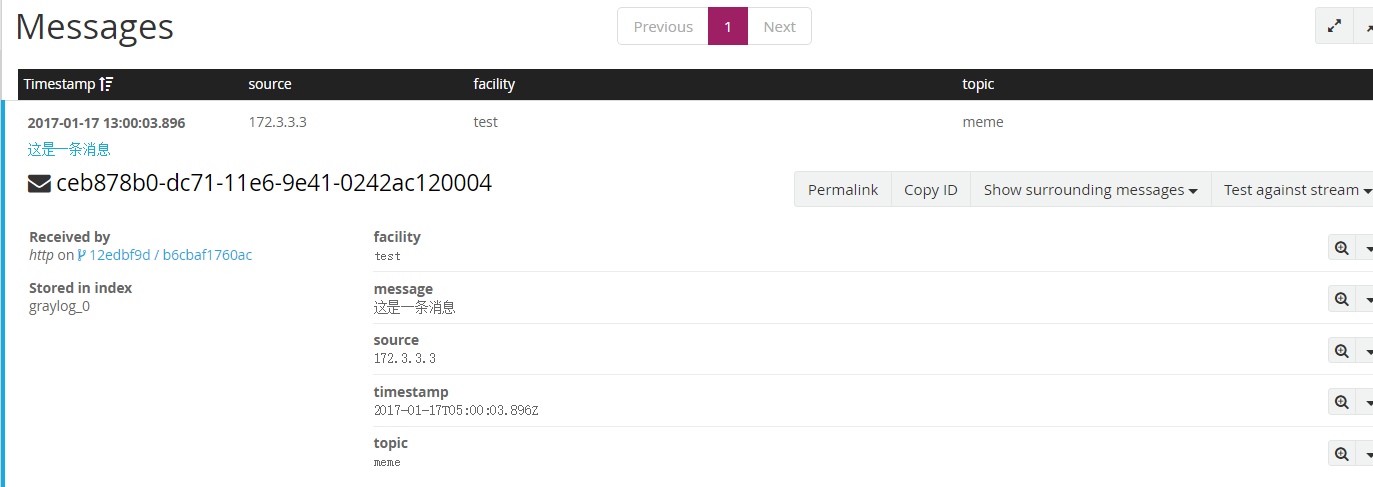
收集服务日志( nodejs 为例)
log4js, bunyan, winston 等等 nodejs 日志框架都可以, 这里我们以 bunyan 为例, 因为 bunyan 可以将日志以 json 的形式打印。
const express = require('express');
const bodyParser = require('body-parser');
const bunyan = require('bunyan');
const log = bunyan.createLogger({
name: 'server-bunyan',
level: 'debug',
streams: [{
type: 'rotating-file',
path: '/data/logs/server-bunyan.log',
period: '1d',
count:
}]
});
const app = express();
app.use(bodyParser.json());
app.use(bodyParser.urlencoded({ extended: true }));
app.get('/hello', (req, res) => {
log.info({
query: req.query
}, 'hello');
res.send('hello world');
});
app.listen(, '0.0.0.0', () => {
log.info('app listening on 5004');
});
rsyslog:
module(load="imfile" PollingInterval="") # input
input(type="imfile" File="/data/logs/server.log" Tag="server" ruleset="push_remote")
input(type="imfile" File="/data/logs/detail.log" Tag="detail" ruleset="push_remote")
input(type="imfile" File="/data/logs/server-bunyan.log" Tag="bunyan_server" ruleset="push_remote") # template
template(name="mytpl" type="string" string="node1 %programname% %msg%\n" )
# output
ruleset(name="push_remote") {
action(
type="omfwd"
protocol="tcp"
target="x.x.x.x"
port=""
template="mytpl"
action.resumeRetryCount="-1"
action.resumeInterval=""
queue.filename="push-remote"
queue.size=""
queue.highwatermark=""
queue.lowwatermark=""
queue.maxdiskspace="100g"
queue.saveonshutdown="on"
queue.type="LinkedList"
queue.maxfilesize="128m"
)
}
新建 input, 监听 515 端口,这里我们体验一下 graylog 的 Extractor,给改 input 添加一个 Extractor:

我们加了一个抓取器,来提取 node, topic 两个字段。
在 webui 查看该 input 的 message:
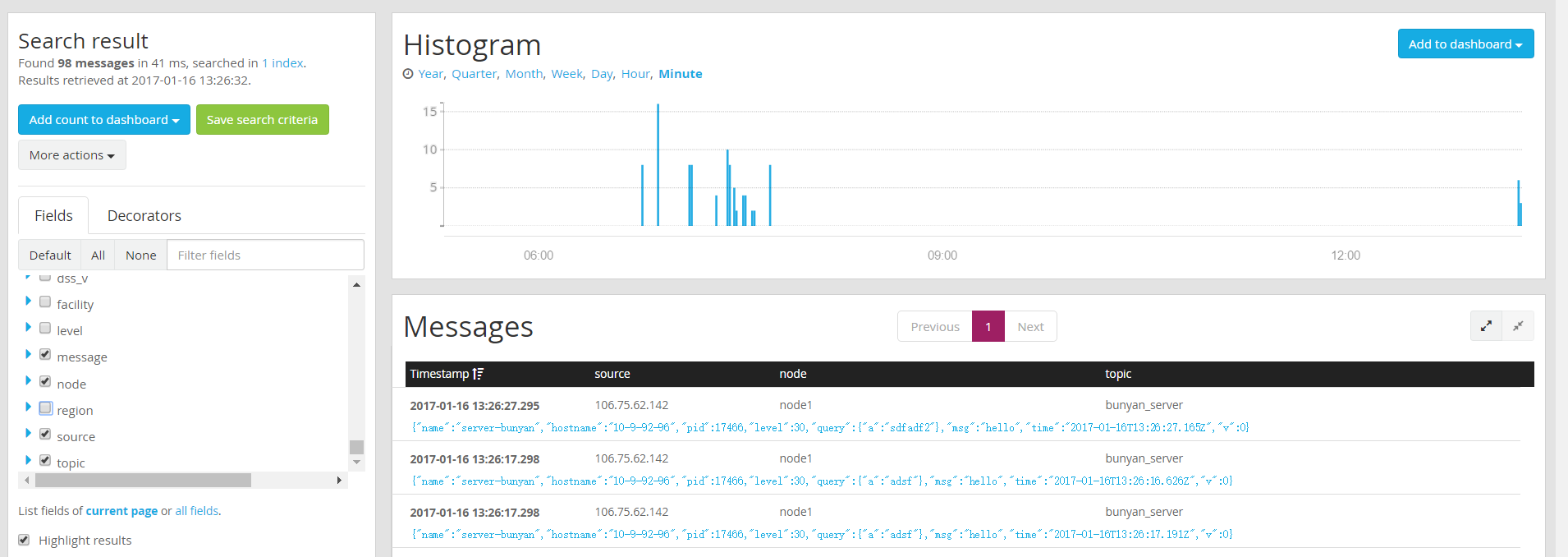
Alerts
Graylog 内置的告警条件:
- 消息数量
- 字段值(number)
- 字段内容
内置告警方式:
- HTTP 回调
体验一下 HTTP 回调。
新建一个 Stream, 进入 manager alerts, 新建一个告警条件:
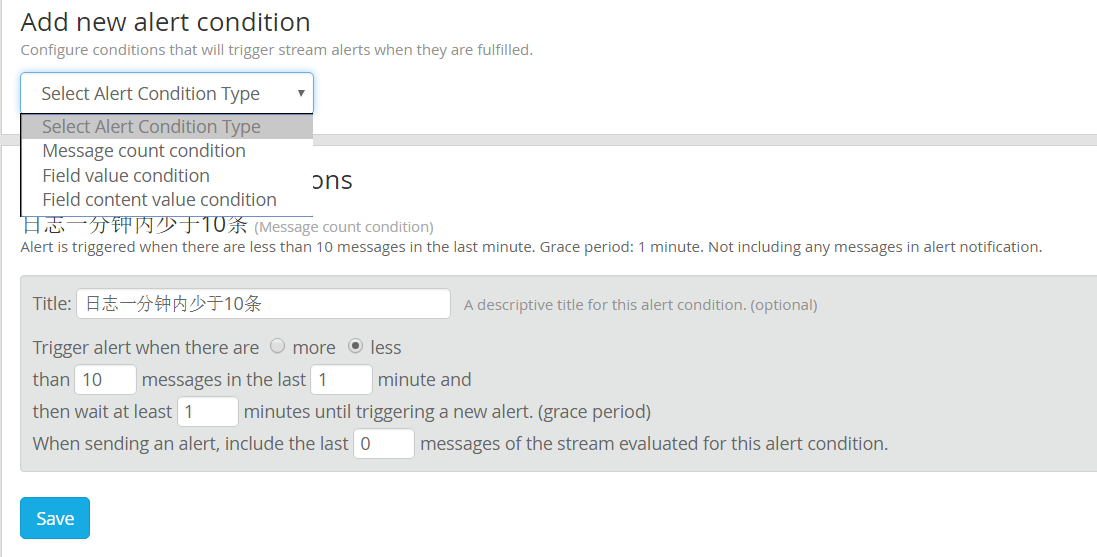
创建一个 HTTP 回调:

告警以 post 方式请求回调, 请求的 body 内容:
{
"check_result": {
"result_description": "Stream had 0 messages in the last 1 minutes with trigger condition less than 10 messages. (Current grace time: 1 minutes)",
"triggered_condition": {
"id": "6bacc1c1-1eac-49f9-9ac8-998ea851f101",
"type": "message_count",
"created_at": "2017-01-17T05:25:13.592Z",
"creator_user_id": "admin",
"title": "日志一分钟内少于10条",
"parameters": {
"grace": ,
"threshold_type": "less",
"threshold": ,
"time": ,
"backlog":
}
},
"triggered_at": "2017-01-17T05:44:11.921Z",
"triggered": true,
"matching_messages": []
},
"stream": {
"creator_user_id": "admin",
"outputs": [],
"alert_receivers": {
"emails": [
"dongsoso@hotmail.com"
],
"users": [
"dongsoso@hotmail.com"
]
},
"matching_type": "AND",
"description": "alert",
"created_at": "2017-01-17T05:21:58.852Z",
"disabled": false,
"rules": [],
"alert_conditions": [
{
"creator_user_id": "admin",
"created_at": "2017-01-17T05:25:13.592Z",
"id": "6bacc1c1-1eac-49f9-9ac8-998ea851f101",
"type": "message_count",
"title": "日志一分钟内少于10条",
"parameters": {
"grace": ,
"threshold_type": "less",
"threshold": ,
"time": ,
"backlog":
}
}
],
"id": "587da9f62ab79c0001352b7a",
"title": "test",
"content_pack": null
}
}
查看告警历史:

更多更好用的功能等待发现…
官方文档 : http://docs.graylog.org/en/2.3/index.html
CentOS 搭建Graylog集群详解的更多相关文章
- 使用acs-engine在Azure中国区部署kubernetes集群详解
转载请注明出处:http://www.cnblogs.com/wayneiscoming/p/7649642.html 1. acs-engine简介 ACS是微软在2015年12月推出的一项基于容器 ...
- redis主从架构,分片集群详解
写在前面:这篇笔记有点长,如果你认真看完,收获会不少,如果你只是忘记了相关命令,请翻到末尾. redis的简单介绍: 一个提供多种数据类类型储存,整个系统都在内存中运行的, 定期通过异步的方式把数据刷 ...
- elasticsearch 集群详解
ES为什么要实现集群 在单台ES服务器节点上,随着业务量的发展索引文件慢慢增多,会影响到效率和内存存储问题等. 如果使用ES集群,会将单台服务器节点的索引文件使用分片技术,分布式的存放在多个不同的物理 ...
- Hadoop(四)HDFS集群详解
前言 前面几篇简单介绍了什么是大数据和Hadoop,也说了怎么搭建最简单的伪分布式和全分布式的hadoop集群.接下来这篇我详细的分享一下HDFS. HDFS前言: 设计思想:(分而治之)将大文件.大 ...
- adoop(四)HDFS集群详解
阅读目录(Content) 一.HDFS概述 1.1.HDFS概述 1.2.HDFS的概念和特性 1.3.HDFS的局限性 1.4.HDFS保证可靠性的措施 二.HDFS基本概念 2.1.HDFS主从 ...
- 【转载】高可用的MongoDB集群详解
1.序言 MongoDB 是一个可扩展的高性能,开源,模式自由,面向文档的数据库. 它使用 C++编写.MongoDB 包含一下特点: l 面向集合的存储:适合存储对象及JSON形式的数据. l ...
- Spark学习笔记--Linux安装Spark集群详解
本文主要讲解如何在Linux环境下安装Spark集群,安装之前我们需要Linux已经安装了JDK和Scala,因为Spark集群依赖这些.下面就如何安装Spark进行讲解说明. 一.安装环境 操作系统 ...
- java架构之路-(MQ专题)RocketMQ从入坑到集群详解
这次我们来说说我们的RocketMQ的安装和参数配置,先来看一下我们RocketMQ的提出和应用场景吧. 早在2009年,阿里巴巴的淘宝第一次提出了双11购物狂欢节,但是在2009年,服务器无法承受到 ...
- CentOS搭建Redis集群
集群原理-redis-cluster架构图 架构细节: (1)所有的redis节点彼此互联(PING-PONG机制),内部使用二进制协议优化传输速度和带宽. (2)节点的fail是通过集群中超过半数的 ...
随机推荐
- [js高手之路]javascript腾讯面试题学习封装一个简易的异步队列
这道js的面试题,是这样的,页面上有一个按钮,一个ul,点击按钮的时候,每隔1秒钟向ul的后面追加一个li, 一共追加10个,li的内容从0开始技术( 0, 1, 2, ....9 ),首先我们用闭包 ...
- 极化码的matlab仿真(2)——编码
第二篇我们来介绍一下极化码的编码. 首先为了方便进行编码,我们需要进行数组的定义 signal = randi([0,1],1,ST); %信息位比特,随机二进制数 frozen = zeros(1, ...
- 第2阶段——编写uboot之硬件初始化和制作链接脚本lds(1)
目标: 1.关看门狗 2.设置时钟 3.初始化SDRAM (初始化寄存器以及清除bss段) 4.重定位 (将nand/nor中代码COPY到链接地址上,需要初始化nandflash,读flash) 5 ...
- 【.net 深呼吸】WPF 中的父子窗口
与 WinForm 不同,WPF 并没有 MDI 窗口,但 WPF 的窗口之间是可以存在“父子”关系的. 我们会发现,Window 类公开了一个属性叫 Owner,这个属性是可读可写的,从名字上我们也 ...
- CCNA+NP学习笔记—交换网络篇
本章关于企业网络的最底层--交换层,难度较低,主要为以后三层的路由做铺垫.所有笔记的分类顺序为:序章→交换层→路由层→运营商,体现了从企业网到互联网的学习顺序. 注:思科设备命令行通常不分大小写!以后 ...
- 【1414软工助教】团队作业8——第二次项目冲刺(Beta阶段) 得分榜
题目 团队作业8--第二次项目冲刺(Beta阶段) 往期成绩 个人作业1:四则运算控制台 结对项目1:GUI 个人作业2:案例分析 结对项目2:单元测试 团队作业1:团队展示 团队作业2:需求分析&a ...
- 团队作业8——Beta 阶段冲刺1st day
一.今日站立式会议照片 二.每个人的工作 (1) 昨天已完成的工作: 今天是冲刺的第一天,昨天完成的是团队成员任务的分配 (2) 今天计划完成的工作: 界面的完善 (3) 工作中遇到的困难: 对于界面 ...
- 团队作业4——第一次项目冲刺(Alpha版本)4th day
一.Daily Scrum Meeting照片 二.燃尽图 三.项目进展 计时功能已经完成,然后24点的代码如何在游戏界面与界面组件联系上正在进行. 四.困难与问题 1.在安卓框架与java代码的结合 ...
- 团队作业4——第一次项目冲刺(Alpha版本) Day1
1.开站立式会议: 2.Leangoo任务分解图: 3.开会讨论的结果,任务分派 队员 今日进展 明日安排 林燕 调查产品的市场需求,学习微信开发 完善逻辑架构框架 王李焕 结合实际分析系统设计思路, ...
- 201521123015 《Java程序设计》第4周学习总结
本周学习总结 1.1 尝试使用思维导图总结有关继承的知识点. 1.2 使用常规方法总结其他上课内容. 1.多态:使用单一接口操作多种类型的对象. 2.private修饰属性,public修饰方法. 3 ...
